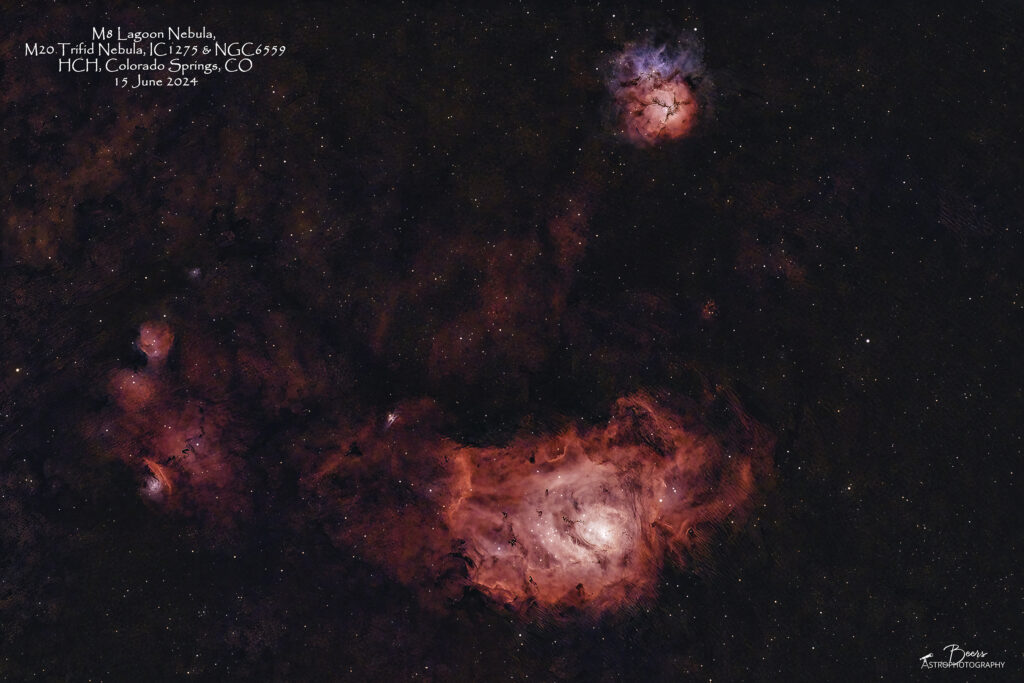
Target Fun Facts
M20 Trifid Nebula: The Trifid Nebula (catalogued as Messier 20 or M20 and as NGC 6514) is an H II region in the northwest of Sagittarius in a star-forming region in the Milky Way’s Scutum–Centaurus Arm. It was discovered by Charles Messier on June 5, 1764. Its name means ‘three-lobe’. The object is an unusual combination of an open cluster of stars, an emission nebula (the relatively dense, reddish-pink portion), a reflection nebula (the mainly NNE blue portion), and a dark nebula (the apparent ‘gaps’ in the former that cause the trifurcated appearance, also designated Barnard 85). The cover of the King Crimson album “Islands” depicts an image of the Trifid Nebula.
The Hubble Telescope close-up images show a dense cloud of dust and gas, which is a stellar nursery full of embryonic stars. This cloud is about 8 light years away from the nebula’s central star. A stellar jet protrudes from the head of the cloud and is about 0.75 light years long. The jet’s source is a young stellar object deep within the cloud. Jets are the exhaust gasses of star formation and radiation from the nebula’s central star makes the jet glow. The images also showed a finger-like stalk to the right of the jet. It points from the head of the dense cloud directly toward the star that powers the Trifid nebula. This stalk is a prominent example of evaporating gaseous globules, or ‘EGGs’. The stalk has survived because its tip is a knot of gas that is dense enough to resist being eaten away by the powerful radiation from the star. In January 2005, NASA’s Spitzer Space Telescope discovered 30 embryonic stars and 120 newborn stars not seen in visible light images.
Other Catalog Designations: M20, NGC 6514, Sharpless 30, RCW 147, Gum 76
Subtype: Combination of an open cluster of stars, an emission nebula, a reflection nebula, and a dark nebula
Distance from Earth: 4,100 light years
Size: 21 light years
Apparent Size: 28’
Magnitude: 6.3
Constellation: Sagittarius
{Target information derived from: https://en.wikipedia.org/wiki/Trifid_Nebula and Stellarium }
Equipment: All equipment controlled by HP Probook running Sequence Generator Pro v4.4.0.1339
- Imaging (ASI2400-BB): ZWO ASI2400MC imaging camera on (Big Bertha) Orion 8″ f/8 Ritchey-Chretien Astrograph Telescope
- Mount: Rainbow Astro RST-135E (controlled by iHubo ASCOM driver)
- Polar alignment: QHYCCD camera (controlled by Polemaster for polar alignment)
- Autoguiding: Orion 60mm Multi-Use Guide Scope with Orion StarShoot AutoGuider Pro Mono Astrophotography Camera (controlled by PHD2)
Capture & Processing Notes: I’d originally planned to image the M8 Lagoon Nebula on the first night of our dark skies trip, but while Paul was driving us in the Beast from home to the Powderhorn area, I checked the APOD and it was entitled Red, White, and Blue – the Trifid Nebula. Seeing that, and having it on my target list for later in the weekend, I was motivated to change up the order and capture my version of the Red, White, and Blue image on the 4th of July! (https://apod.nasa.gov/apod/ap240704) I had a few electrical connection start-up issues, but once I un-/re-plugged the power into the camera the laptop finally recognized it and everything proceeded as planned. The booster (to boost the voltage coming from the Beast’s 12V battery to ~14V for the larger mount I use for Big Bertha (Rainbow Astro RST-300) to properly operate) worked like a charm! Even at the end of the night, the voltage was 13.8V. I didn’t bother stacking the M20 images while I was in camp, since I could tell from the capture (i.e., see in the individual images) that it went well.
Sequence Plan (4Jul2024): Gain: 158, Temp: -0°C, offset=30. 40x5min. Captured 4Jul2024, 2339MDT – 5Jul2024, 0313MDT. Total exposure time: 3:20hrs (ASI2400-BB)
Processing: Captured in SGP, stacked in APP (Adaptive Airy), star removal with Starnet++, processing with LR/PS
Other images of this object

Capture Notes
Received the RST-135E’s hand controller back from Tolga, after he changed out the GPS card in it. When it arrived, I took the telescope out onto the patio and validated that everything was working correctly. This was the first clear night to image with all the “fixed” equipment. Although there were several warnings from SGPro throughout the imaging session that the autoguider was struggling and recovery mode was invoked several times (I need to remember to focus the autoguider camera before the next imaging session). Things went well – including the meridian flip that executed on its own at some point before the 20 minutes past the median point. I set an alarm and went out to do the meridian flip – SGP said it was about 1:40 minute before the flip and there was about 45 seconds left in the exposure. So I selected “pause sequence” but forgot to check “run end of sequence actions.” When the sequence paused, I looked up at the mount and realized that it was already on the east side of the pier (i.e., had executed the meridian flip). Even though it was quarter moon, the LPro filter produced a great result.
Equipment
All equipment controlled by HP Probook running Sequence Generator Pro v4.4.0.1339.
- Imaging (ASI2400-SC-LPro): ZWO ASI2400MC imaging camera with Optolong L-Pro LP filter on (Southern Cross) Askar FRA600 108mm f/5.6 Quintuplet Petzval Flat-Field Astrograph.
- Autofocuser: ZWO EAF Electronic Automatic Focuser – Standard (EAF-5V-STD)
- Mount: Rainbow Astro RST-135E (controlled by iHubo ASCOM driver)
- Polar alignment: QHYCCD camera (controlled by Polemaster for polar alignment)
- Autoguiding: Orion 60mm Multi-Use Guide Scope with Orion StarShoot AutoGuider Pro Mono Astrophotography Camera (controlled by PHD2)
Capture & Processing Notes:
Sequence Plan (4Jul2024): Gain: 158, Temp: -0°C, offset=30. 31x5min. Captured 16Jun2024, 0031MDT – 0313MDT. Total exposure time: 2:35hrs (155min, ASI2400-SC)
Captured: Night of 15 June 2024
Shooting Location: Colorado Springs, Colorado
